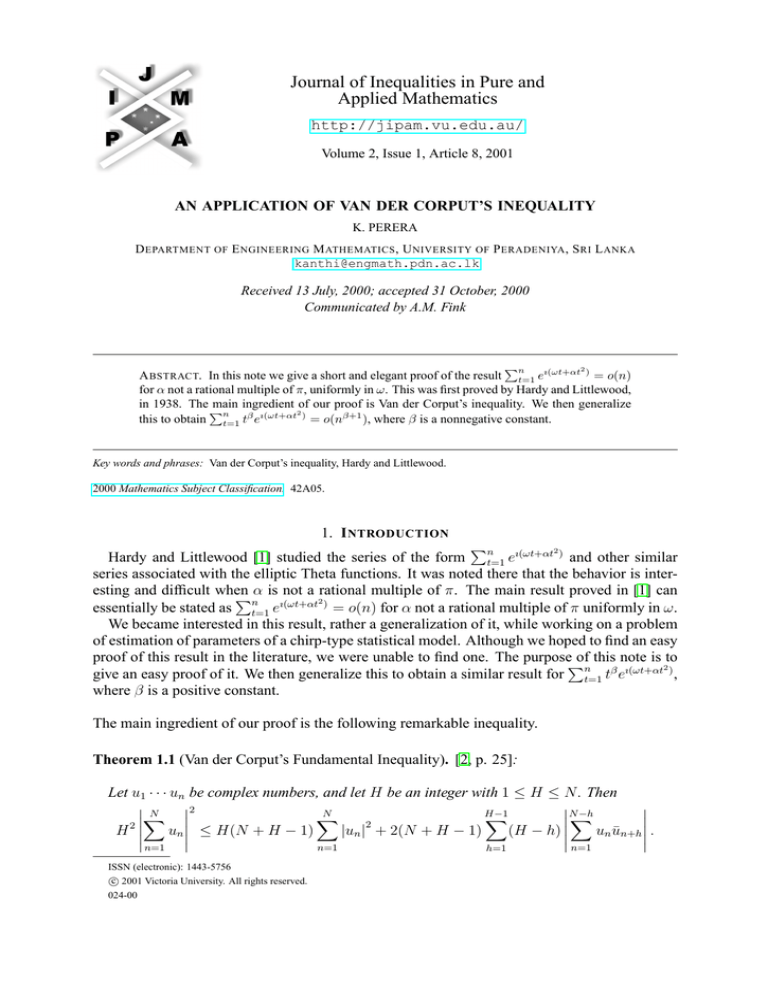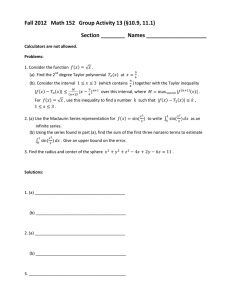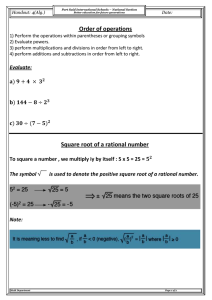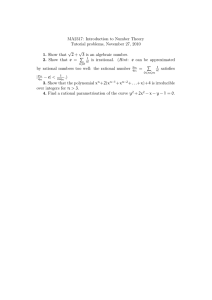
Journal of Inequalities in Pure and
Applied Mathematics
http://jipam.vu.edu.au/
Volume 2, Issue 1, Article 8, 2001
AN APPLICATION OF VAN DER CORPUT’S INEQUALITY
K. PERERA
D EPARTMENT OF E NGINEERING M ATHEMATICS , U NIVERSITY OF P ERADENIYA , S RI L ANKA
kanthi@engmath.pdn.ac.lk
Received 13 July, 2000; accepted 31 October, 2000
Communicated by A.M. Fink
Pn
2
A BSTRACT. In this note we give a short and elegant proof of the result t=1 eı(ωt+αt ) = o(n)
for α not a rational multiple of π, uniformly in ω. This was first proved by Hardy and Littlewood,
in 1938. The main ingredient of our proof is Van der Corput’s inequality. We then generalize
Pn
2
this to obtain t=1 tβ eı(ωt+αt ) = o(nβ+1 ), where β is a nonnegative constant.
Key words and phrases: Van der Corput’s inequality, Hardy and Littlewood.
2000 Mathematics Subject Classification. 42A05.
1. I NTRODUCTION
P
2
Hardy and Littlewood [1] studied the series of the form nt=1 eı(ωt+αt ) and other similar
series associated with the elliptic Theta functions. It was noted there that the behavior is interesting and difficult when
not a rational multiple of π. The main result proved in [1] can
Pnα is ı(ωt+αt
2)
essentially be stated as t=1 e
= o(n) for α not a rational multiple of π uniformly in ω.
We became interested in this result, rather a generalization of it, while working on a problem
of estimation of parameters of a chirp-type statistical model. Although we hoped to find an easy
proof of this result in the literature, we were unable to find one. The purposeP
of this note is to
2
give an easy proof of it. We then generalize this to obtain a similar result for nt=1 tβ eı(ωt+αt ) ,
where β is a positive constant.
The main ingredient of our proof is the following remarkable inequality.
Theorem 1.1 (Van der Corput’s Fundamental Inequality). [2, p. 25]:
Let u1 · · · un be complex numbers, and let H be an integer with 1 ≤ H ≤ N . Then
N −h
N
N
H−1
X
X 2
X
X
H2 un ≤ H(N + H − 1)
|un |2 + 2(N + H − 1)
(H − h) un ūn+h .
n=1
ISSN (electronic): 1443-5756
c 2001 Victoria University. All rights reserved.
024-00
n=1
h=1
n=1
2
K. P ERERA
2. M AIN R ESULT
Theorem 2.1. Let β be a nonnegative real number. Then
not a rational multiple of π, uniformly in ω.
Pn
t=1
tβ eı(ωt+αt
2)
= o(nβ+1 ), for α
2
Proof. By using Van der Corput’s inequality with fixed H and ut = eı(ωt+αt ) , we obtain
2
n
n X
X
2
ı(ωt+αt2 ) 2
(2.1) H 2 eı(ωt+αt ) ≤ H(n + H − 1)
e
t=1
t=1
+2
H−1
X
h=1
n−h
X
(n + H − 1)(H − h) ut ūt+h t=1
2
for all n ≥ H. But ut ūt+h = e−ıωh−ıαh −2ıαth , and so
n−h
n−h
X
X
−2ıαth e
ut ūt+h = .
t=1
t=1
Substituting this in the inequality (2.1), we obtain
2
n
H−1
n−h
X
X
X
2
2
ı(ωt+αt )
−2ıαth H e
(n + H − 1)(H − h) e
≤ H(n + H − 1)n + 2
.
t=1
t=1
h=1
Thus
(2.2)
n
2
n−h
H−1
1 X
X (n + H − 1)(H − h) X
1
1
1
2
ı(ωt+αt )
−2ıαth e
+ −
+2
e
≤
.
n t=1
H n nH
n2 H 2
t=1
h=1
Let
Mn (α, h) =
n−h
X
e−2ıαth .
t=1
Thus if α is not a rational multiple of π we can write Mn (α, h) in the following form.
Mn (α, h) = e−ıαh(n−h+1)
sin[(n − h)αh]
.
sin(αh)
Then
|Mn (α, h)| ≤
1
.
|sin(αh)|
If h0 is the member of {1, 2, · · · , (H − 1)} for which
|sin(αh0 )| =
min
1≤h≤H−1
|sin(αh)| ,
then
|Mn (α, h)| ≤
J. Inequal. Pure and Appl. Math., 2(1) Art. 8, 2001
1
.
|sin(αh0 )|
http://jipam.vu.edu.au/
A N A PPLICATION OF VAN DER C ORPUT ’ S I NEQUALITY
3
Substituting this in equation (2.2) we get
2
n
1 X
1
1
1
2
eı(ωt+αt ) ≤
+ −
n
H n nH
t=1
+2
H−1
X
h=1
1
(n + H − 1)(H − h)
n2 H 2
|sin(α, h0 )|
1
1
1
2
≤
+ −
+
.
H n nH n |sin(αh0 )|
Since this is true for all n ≥ H, we obtain
n
2
1 X
1
2
lim eı(ωt+αt ) ≤ .
n→∞ n
H
t=1
Since this is true for all H ≥ 1, it follows that
n
2
1 X
ı(ωt+αt2 ) lim e
= 0,
n→∞ n
t=1
uniformly in ω. That is, if α is not a rational multiple of π,
n
X
2
(2.3)
eı(ωt+αt ) = o(n),
t=1
uniformly in ω.
P
2
Now we will show that nt=1 tβ eı(ωt+αt ) = o(nβ+1 ) provided α is not a rational multiple of
π. Let
Q0 (ω, α) = 0,
and, for n ≥ 1,
n
n
X
X
2
2
Qn (ω, α) =
eı(ωt+αt ) and Sn (ω, α) =
tβ eı(ωt+αt ) .
t=1
t=1
Then
Sn (ω, α) =
n
X
tβ [Qt (ω, α) − Qt−1 (ω, α)]
t=1
= nβ Qn (ω, α) − Q0 (ω, α) −
n−1
X
[(t + 1)β − tβ ]Qt (ω, α)
t=1
(2.4)
= nβ Qn (ω, α) −
n−1
X
ft (ω, α),
t=1
where
fn (ω, α) = [(n + 1)β − nβ ]Qn (ω, α)
By the mean-value theorem we have
(n + 1)β − nβ = β ñβ−1
If 0 ≤ β ≤ 1, then ñ
that, for β ≥ 0,
β−1
≤n
β−1
where
, while if β ≥ 1, then ñ
(2.5)
J. Inequal. Pure and Appl. Math., 2(1) Art. 8, 2001
for
n = 1, 2, . . .
n ≤ ñ ≤ n + 1.
β−1
≤ (n + 1)β−1 ≤ (2n)β−1 . It follows
(n + 1)β − nβ ≤ cβ nβ−1 ,
http://jipam.vu.edu.au/
4
K. P ERERA
where cβ is a constant. Hence
|fn (ω, α)| ≤ cβ nβ−1 |Qn (ω, α)| .
But by (2.3), if α is not a rational multiple of π, then Qn (ω, α) = o(n) uniformly in ω.
Thus if α is not a rational multiple of π, then
|fn (ω, α)| ≤ cβ nβ−1 o(n),
so
fn (ω, α) = o(nβ ).
uniformly in ω. However, fn (ω, α) = o(nβ ) implies that the mean
Hence, if α is not a rational multiple of π,
n−1
X
1
n−1
Pn−1
t=1
ft (ω, α) is o(nβ ).
ft (ω, α) = o(nβ+1 ),
t=1
uniformly in ω. But by (2.4)
β
Sn (ω, α) = n Qn (ω, α) −
n−1
X
ft (ω, α).
t=1
β+1
It follows that Sn (ω, α) = o(n ), for α not a rational multiple of π, uniformly in ω.
This completes the proof of the Theorem.
R EFERENCES
[1] G.H. HARDY AND J.E. LITTLEWOOD, Some Problems of Diophantine Approximation. Acta
Mathematica Band 37 s. 193-238 [Volume 1 of Collected Works of G.H. Hardy]. (1914).
[2] L. KUIPERS
(1974).
AND
H. NIEDERREITER, Uniform Distribution of Sequences, Wiley, New York,
J. Inequal. Pure and Appl. Math., 2(1) Art. 8, 2001
http://jipam.vu.edu.au/






